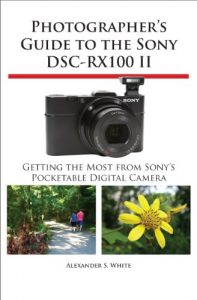With the release of the DSC-RX100 II camera, Sony has built upon the success of the earlier RX100 model, adding a hot shoe, tilting LCD screen, Wi-Fi capability, upgraded digital sensor, and other enhancements. White Knight Press, which published a well-received guide to the RX100, has just released Photographer’s Guide to the Sony RX100 II, a new book that addresses all of the new features of the RX100 II and includes a full discussion of the many advanced features that are common to both camera models.
With the publication of this book, author Alexander White provides users of the RX100 II with a guide to all operations, features, menus, and controls of the camera. Using a tutorial-like approach, the book shows beginning and intermediate photographers not only how to accomplish things with the RX100 II, but when and why to use the camera’s features. The book does not assume specialized knowledge by the reader as it explains topics such as autofocus, manual focus, depth of field, aperture priority, shutter priority, exposure compensation, white balance, and ISO sensitivity. The book provides details about the camera’s numerous shooting modes as well as its menu options for shooting, playback, setup, and special effects. The book includes complete coverage of the new features of the RX100 II, including the capability to transfer images and videos over a wireless network and to control the camera remotely with a smartphone or tablet.
The book includes nearly 400 color photographs that illustrate the camera’s controls, display screens, and menus. The images also provide examples of the photographs that can be taken using the RX100 II’s Photo Creativity settings, which alter the color processing of images; the Scene shooting mode, with settings that are optimized for various subjects, including landscapes, portraits, and action shots; the Creative Style and Picture Effect menu options, which offer dramatic options for altering the appearance of images; and the camera’s features for continuous shooting and shooting in dim lighting.
In addition, the book provides introductions to more advanced topics such as infrared photography, street photography, astrophotography, digiscoping, and macro photography.
The book includes a full discussion of the video recording abilities of the RX100 II, which can shoot high-definition (HD) video with stereo sound, and which offers manual control of exposure and focus during movie recording.
In three appendices, the book provides information about accessories for the RX100 II, including cases, external flash units, viewfinders, and filter adapters, and includes a list of web sites and other resources for further information. The book includes an appendix with “quick tips” on how to take advantage of the camera’s features in the most efficient ways possible.
This guide to the RX100 II includes a detailed index, so the reader can quickly find needed information about any particular feature or aspect of the camera.
With the publication of this book, author Alexander White provides users of the RX100 II with a guide to all operations, features, menus, and controls of the camera. Using a tutorial-like approach, the book shows beginning and intermediate photographers not only how to accomplish things with the RX100 II, but when and why to use the camera’s features. The book does not assume specialized knowledge by the reader as it explains topics such as autofocus, manual focus, depth of field, aperture priority, shutter priority, exposure compensation, white balance, and ISO sensitivity. The book provides details about the camera’s numerous shooting modes as well as its menu options for shooting, playback, setup, and special effects. The book includes complete coverage of the new features of the RX100 II, including the capability to transfer images and videos over a wireless network and to control the camera remotely with a smartphone or tablet.
The book includes nearly 400 color photographs that illustrate the camera’s controls, display screens, and menus. The images also provide examples of the photographs that can be taken using the RX100 II’s Photo Creativity settings, which alter the color processing of images; the Scene shooting mode, with settings that are optimized for various subjects, including landscapes, portraits, and action shots; the Creative Style and Picture Effect menu options, which offer dramatic options for altering the appearance of images; and the camera’s features for continuous shooting and shooting in dim lighting.
In addition, the book provides introductions to more advanced topics such as infrared photography, street photography, astrophotography, digiscoping, and macro photography.
The book includes a full discussion of the video recording abilities of the RX100 II, which can shoot high-definition (HD) video with stereo sound, and which offers manual control of exposure and focus during movie recording.
In three appendices, the book provides information about accessories for the RX100 II, including cases, external flash units, viewfinders, and filter adapters, and includes a list of web sites and other resources for further information. The book includes an appendix with “quick tips” on how to take advantage of the camera’s features in the most efficient ways possible.
This guide to the RX100 II includes a detailed index, so the reader can quickly find needed information about any particular feature or aspect of the camera.






